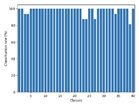Overview
The work on texture characterization and classification has considered two different approaches.
- Texture characterization using transform-based features
The objective is to define a series of simple binary classifiers to discriminate one class of textures against all others. These simple binary classifiers are based on the identification of relevant features that are extracted using transformations such as wavelets, shearlets, total variations, and local binary patterns, which are applied after a texture-cartoon separation.
Once the relevant features are identified, a Support Vector Machine is used to determine the threshold in the functional that allows maximum discrimination between the classes.
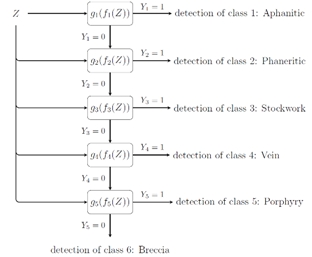
The simple binary classifiers are combined in a sequential classifier.
The approach was designed over a simplified database of 96 images (128 x 128 pixels), with 16 images for each one of the 6 texture classes: aphanitic, phaneritic, porphyry, stockwork, vein, breccia. In this setting, a success rate of 75.3% matching was obtained.
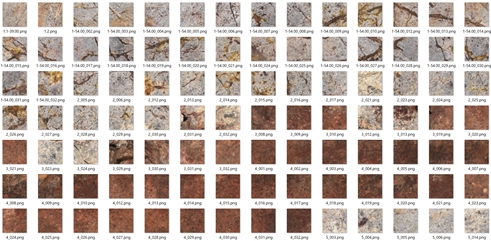
A pilot test was then prepared over a real drillhole dataset, where photographs for 1200m were available from a porphyry copper deposit in Chile. From these, 150m were used to extract about 14,000 images (128 x 128 pixels in size).
326 images were classified in one of the six categories by experienced geologists. This constitutes 2.34% of the total database. The classification approach was applied, obtaiing a 64% match over the validation data. The misclassified cases were analyzed and images were pre-processed to improve the classification success. A simple filtering approach and normalization of the images (in terms of brightness and contrast) were applied. The success rate over the validation set raised to 84.8%.

- Texture characterization using variographic tools
A different approach to characterize the texture images is to measure their spatial correlation. A variogram map can be used to characterize the spatial continuity for different directions in an image.
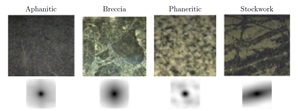 Since the variogram map has a high dimensionality and is highly redundant due to symmetry, a compact variogram representation can be used, inspired by the Local Binary Pattern concept. Only a limited number of points is selected from the variogram map, to summarize its features, reducing significantly the dimensionality of the feature vector.
Since the variogram map has a high dimensionality and is highly redundant due to symmetry, a compact variogram representation can be used, inspired by the Local Binary Pattern concept. Only a limited number of points is selected from the variogram map, to summarize its features, reducing significantly the dimensionality of the feature vector.
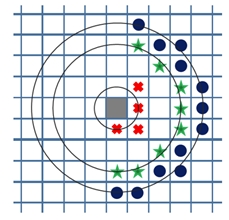 The image shows the 24 points vector used to summarize the variogram map, by considering only 4 points at lag 1, 8 points at lag 3 and 12 points at lag 4, covering different distances and angles. This implies a reduction in dimensionality of the original variogram map made of 441 values (21×21 lags) to only 24 values.
The image shows the 24 points vector used to summarize the variogram map, by considering only 4 points at lag 1, 8 points at lag 3 and 12 points at lag 4, covering different distances and angles. This implies a reduction in dimensionality of the original variogram map made of 441 values (21×21 lags) to only 24 values.
A further improvement of this is to consider the distribution of squared differences for the lags in the compact representation, instead of the average (as used in the variogram map). This implies that the variability of the variogram information from different zones of the image is accounted for. The distribution of squared differences for each one of the values (lags) of the compact representation of the variogram is characterized with its probability density function (pdf).
The classification process is done using the k-Nearest Neighbours method using different metrics when comparing vectors (Euclidean distance, normalized Euclidean distance, relative L1 distance) or when comparing distributions (Kullback-Leibler divergence, symmetric Kullback-Liebler distance, Riemannian distance).
The method was applied to several cases, with excellent results.
| Results indicate a classification success of 70.8% over the training database (96 images, 16 per class). In addition to this application, the method was applied to a modified database with clean geological textures (Breccia with full clasts in the image, Veins clearly defined, Stockwork clearly defined), showing a boost in performance to 83.3%. This indicates that this method works really well when textures are “clean”. | 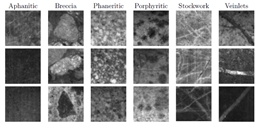 |
| The method was also applied to the standard VisTex database, with a 98.1% classification rate
|
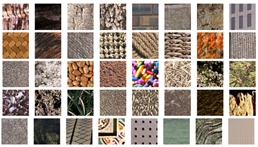 |
| It was also used with the standard USPTex database, with an 88.0% classification rate
|
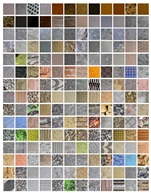 |
| Finally, it was applied to two foam image databases from froth flotation processes using three different reagents, achieving a 100% rate to discriminate from the foam image, the agent used, in the first case, and achieving a 98.9% rate in the second case, considering images using different reagents and different flotation column heights.
|
 |
Future work
Currently, research is focusing on improving the methods described previously, as well as exploring an unsupervised approach to cluster textures based on different features. These features have been explored in the research previously described, and include: continuity features, object extraction, morphological features, transform-based responses. The goal is to characterize the images through these features and apply a clustering scheme to discriminate them based on the feature vector values. These materials could then be correlated to metallurgical tests to be used as proxy for geometallurgical domaining.
References
- Diaz G, Ortiz JM, Silva JF, Lobos R, Egana A (2017) Variogram-based description for classification of rock image textures, in preparation.
- Ortiz JM, Marulanda Y (2017) Semi-Automated Texture Classification for Geometallurgical Applications, 18th Annual Conference IAMG 2017, September 2-9, 2017, Perth, Australia.
- Lobos R, Silva JF, Ortiz JM, Diaz G, Egana A (2016) Analysis and classification of natural rock textures based on new transform-based features, Math Geosci 48(7):835-870.
- Ortiz JM (2017) Geometallurgical workflows to optimize mining decisions, CIM public lecture, McGill University, March 29, 2017, Montreal, QC, Canada.
- Diaz G, Egana A, Cortes M, Ortiz J (2016) Rock texture discrimination: a new tool for geological characterization, MININ 2016: 6th International Conference on Innovations in Mine Operations, August 21-23, 2016, Santiago, Chile.
- Ortiz JM, Kracht W, Townley B, Lois P, Cardenas E, Miranda R, Alvarez M (2015) Workflows in geometallurgical prediction: challenges and outlook, 17th Annual Conference IAMG 2015, September 5-13, 2015, Freiberg, Germany.

